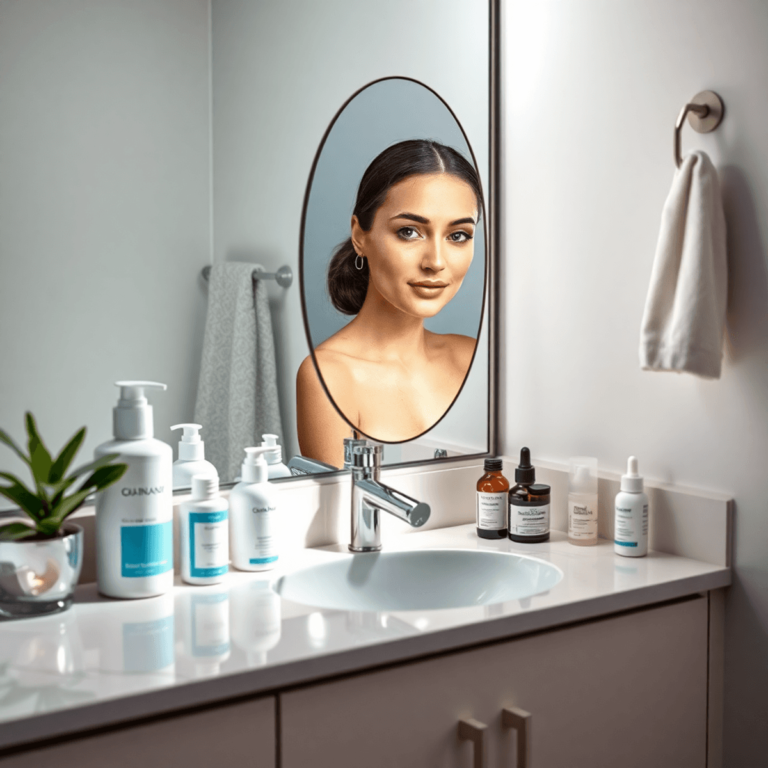How long does it take a pimple to go away?

Introduction
Pimples are a common skin condition, often associated with acne. They occur when hair follicles become clogged with oil, dead skin cells, and bacteria. Understanding the nature of pimples is essential for effective management.
Common Causes of Pimples
- Excess Oil Production: Sebaceous glands produce excess sebum leading to clogged pores.
- Hormonal Changes: Fluctuations in hormones can trigger increased oil production.
- Bacterial Growth: Propionibacterium acnes, a bacteria naturally present on the skin, can contribute to inflammation.
- Diet and Lifestyle: Unhealthy eating habits and high-stress levels may exacerbate acne.
Recognizing the healing time of pimples can significantly impact your approach to treatment. Most pimples last between three to seven days but can vary based on their type and severity. Understanding this timeline helps set realistic expectations for recovery and informs your skincare choices. Being informed empowers you to take control of your skin health and explore appropriate treatment options effectively.
Understanding the Formation of Pimples
Pimples are a common skin condition characterized by small, inflamed bumps on the skin’s surface. They often occur when hair follicles become clogged with oil, dead skin cells, and bacteria. Understanding how pimples form requires examining several key factors.
What are Pimples?
Pimples can vary in appearance and severity. They may manifest as whiteheads, blackheads, or more inflamed types like pustules or cysts. Regardless of type, each pimple shares similar underlying causes related to skin health.
How do They Form?
The formation of a pimple begins deep within the hair follicle. Here’s a breakdown of the process:
- Excess Sebum Production: Sebaceous glands produce sebum, an oily substance that helps keep skin moisturized. When sebum production increases, it can lead to clogged pores.
- Buildup of Dead Skin Cells: The skin naturally sheds dead cells. If these cells accumulate and mix with excess sebum, they can block hair follicles.
- Bacterial Growth: Propionibacterium acnes, a type of bacteria that resides on the skin, thrives in environments rich in oil and dead skin cells. When follicles become clogged, this bacteria can multiply rapidly.
- Inflammation Response: The body recognizes the bacterial growth as an invader and triggers an inflammatory response. This leads to redness, swelling, and pus formation characteristic of many pimples.
The Role of Oil Glands and Bacteria in Pimple Formation
Oil glands play a vital role in maintaining skin health through the production of sebum. However, when these glands become overactive or when external factors contribute to clogging—such as hormonal changes or diet—pimples can develop more frequently. The presence of bacteria exacerbates this issue by further inflaming the area and leading to more severe acne conditions.
Understanding these elements provides insight into not just how pimples form but also highlights potential preventive measures that can be taken through proper skincare practices and lifestyle choices.
Exploring Different Types of Pimples and Their Healing Times
Pimples can come in different forms, each with its own characteristics and healing times. Knowing these types can help you take care of your skin better.
Types of Pimples
1. Whiteheads
These are small, closed pores that appear white or flesh-colored. They occur when excess oil, dead skin cells, and bacteria accumulate beneath the skin’s surface. Healing time typically ranges from a few days to a week.
2. Blackheads
Unlike whiteheads, blackheads are open comedones. They appear dark due to oxidation of the clogged material when exposed to air. Healing can take about 3 to 10 days depending on treatment.
3. Papules
These small, raised bumps are often red and tender. Papules result from inflammation around blocked hair follicles. Healing may take anywhere from 5 to 7 days.
4. Pustules
Characterized by a white or yellow pus-filled center, pustules are inflamed bumps that can be painful. Healing time generally varies from 5 to 10 days.
Comparison of Healing Times
The healing times for different types of pimples vary based on their severity:
- Superficial Pimples: Generally heal faster within 3 to 5 days.
- Inflamed Pimples: These take longer due to increased redness and swelling. Expect healing in about 1 week to 2 weeks.
- Cystic Acne: This form is more severe and occurs deep within the skin, often resulting in larger, painful lumps. Cystic acne can take several weeks to heal completely, sometimes extending beyond six weeks.
Severity and Duration
The severity of a pimple significantly influences its duration:
- Smaller, superficial pimples tend to resolve quickly.
- Larger or more inflamed pimples may persist longer due to deeper infection and inflammation.
Understanding these differences allows you to tailor your skincare routine effectively and set realistic expectations for healing times.
Average Healing Time for Most Pimples: What to Expect?
Knowing how long it usually takes for pimples to heal can help you manage your skincare better. Most pimples typically heal within 3 to 7 days, but this can vary based on a few factors.
Key Factors Affecting Healing Duration:
- Size: Smaller, surface-level pimples usually heal faster than larger, inflamed ones. The more extensive the infection or blockage, the longer it may take for your skin to recover.
- Inflammation: If a pimple is particularly inflamed or painful, it may indicate a deeper infection that requires additional time to heal. Inflamed pimples often take longer due to increased blood flow and immune response in the area.
Deeper or Cystic Pimples
Some types of acne, like cystic pimples, can take longer than usual to heal. Cystic acne forms deep within the skin and can last for several weeks. Here are some characteristics of these stubborn pimples:
- Painful lumps under the skin that may not come to a head.
- Prolonged healing time, often taking anywhere from weeks to months before fully resolving.
The combination of excess oil production, dead skin cells, and bacteria contributes to their stubborn nature. Because these types of pimples are deeply rooted, they require more comprehensive treatment approaches to speed up recovery.
Understanding these factors can help you better understand how your skin behaves and set realistic expectations for pimple healing time. By taking proactive steps in your skincare routine, you can further support your efforts in achieving clearer skin.
Exploring Treatment Options to Speed Up Pimple Healing Process
Effective treatment methods for pimples can significantly reduce healing time. It’s important to understand the differences between over-the-counter (OTC) treatments and prescription medications.
Over-the-Counter Treatments
Over-the-counter treatments are products that you can buy without a prescription. They are often the first line of defense against mild to moderate acne. Here are some common OTC treatments:
- Benzoyl Peroxide: This ingredient targets the bacteria responsible for acne and helps reduce inflammation.
- Salicylic Acid: Salicylic acid works by unclogging pores and promoting exfoliation, which can prevent future breakouts.
- Alpha Hydroxy Acids (AHAs): AHAs are acids derived from fruits that help remove dead skin cells and improve skin texture.
These products can be effective for mild to moderate acne. They are readily available and easy to incorporate into your daily routine. However, keep in mind that results may take time, often requiring consistent application over several days.
Prescription Medications
If your acne is more severe or doesn’t respond to OTC treatments, you may need prescription medications. Dermatologists commonly recommend:
- Topical Retinoids: These medications increase cell turnover and prevent clogged pores.
- Antibiotics: Antibiotics reduce the bacteria on your skin and decrease inflammation.
- Hormonal Treatments: Hormonal treatments address underlying hormonal imbalances that contribute to acne.
Importance of a Consistent Skincare Routine
In addition to using specific treatments, having a consistent skincare routine is crucial for managing acne. Here are some key components of an effective skincare routine:
- Cleansing: Use a gentle cleanser twice daily to remove excess oil and dirt from your skin.
- Moisturizing: Choose non-comedogenic moisturizers that won’t clog your pores while keeping your skin hydrated.
- Sun Protection: Apply sunscreen every day to protect your skin from harmful UV rays during the healing process.
Influence of Dietary Choices and Stress Levels
Your diet and stress levels can also impact the health of your skin. Here are some factors to consider:
- Dietary Choices: Certain foods, such as those high in sugar or dairy, may trigger or worsen acne for some people. On the other hand, incorporating anti-inflammatory foods like fruits, vegetables, and omega-3 fatty acids into your diet can support clearer skin.
- Stress Management: Chronic stress can lead to hormonal fluctuations that trigger breakouts. Finding healthy ways to manage stress through activities like exercise, meditation, or yoga can help minimize its effects on your skin.
By understanding these different treatment options and making necessary lifestyle changes, you can speed up the healing process of pimples and achieve clearer skin over time.
Effective Treatments to Consider for Quick Pimple Recovery (Topical Treatments)
When dealing with pimples, selecting the right topical treatments for faster healing can make a significant difference in reducing their duration and severity. Here are two of the most effective options:
1. Salicylic Acid
- Mechanism: Salicylic acid is a beta hydroxy acid (BHA) known for its exfoliating properties. It penetrates deep into the pores, helping to break down the debris and dead skin cells that contribute to clogged oil glands.
- Benefits: This treatment not only clears existing pimples but also helps prevent future breakouts by keeping the pores clear. Regular use can lead to smoother skin texture and reduced inflammation.
2. Benzoyl Peroxide
- Mechanism: Benzoyl peroxide functions primarily as an antibacterial agent, targeting the bacteria responsible for acne. It also helps to reduce excess oil production.
- Benefits: This treatment effectively dries out active pimples and reduces redness and swelling associated with inflammation. It can be particularly useful for those with inflamed papules or pustules.
Application Tips
- Both salicylic acid and benzoyl peroxide are available in various forms, including gels, creams, and spot treatments.
- Start with a lower concentration to gauge your skin’s tolerance before progressing to stronger formulations.
Using these topical treatments as part of your skincare routine can significantly expedite the healing process of pimples. Proper application and consistency are key in achieving noticeable results.
Natural Remedies That May Aid in Faster Healing
Natural remedies for faster healing can provide effective alternatives to conventional treatments. Here are two popular options:
1. Tea Tree Oil
Antimicrobial Properties
Tea tree oil is known for its ability to combat bacteria and reduce inflammation.
Application
Dilute tea tree oil with a carrier oil, like coconut or jojoba oil, before applying it directly to the affected area. This helps prevent skin irritation.
Effectiveness
Studies have shown that tea tree oil can significantly reduce the number of acne lesions and improve overall skin appearance.
2. Aloe Vera
Soothing Qualities
Aloe vera is renowned for its calming effects on the skin. It hydrates while promoting healing, making it ideal for inflamed pimples.
####Nutrient-Rich
Packed with vitamins A, C, and E, aloe vera nourishes the skin and aids in repairing damaged tissues.
Usage
Apply fresh aloe vera gel from the plant directly to your pimples. This not only provides relief but also helps reduce redness and swelling.
Both tea tree oil and aloe vera are widely available, making them accessible options for those seeking natural treatments. Incorporating these remedies into your skincare routine may help expedite pimple recovery while minimizing potential side effects associated with harsher chemicals.
When to Seek Professional Help or Prescribed Treatments (Prescription Medications)
Pimples can often be managed with over-the-counter solutions, but certain situations warrant professional intervention. Recognizing when to consult a dermatologist is essential for effective treatment.
Consider seeking professional help if you experience:
- Persistent Acne: If your pimples do not improve after several weeks of consistent over-the-counter treatments, it may indicate a more severe form of acne that requires prescription medications for faster healing.
- Severe Inflammation: Large, swollen, and painful pimples may benefit from stronger medications prescribed by a healthcare provider. This includes options such as corticosteroids to reduce inflammation rapidly.
- Cystic Acne: Deep, cystic pimples can take much longer to heal and often require specific treatments like isotretinoin or other oral medications that target the root causes of acne.
- Scarring Concerns: If you notice scarring or hyperpigmentation forming as a result of your acne, consulting a dermatologist can help you find appropriate treatments to minimize these effects.
- Acne’s Psychological Impact: When pimples affect your mental health—leading to anxiety or depression—professional support may provide not only medical treatment but also counseling options.
Prescription medications for faster healing come in various forms, including topical retinoids, antibiotics, and hormonal treatments. These options are tailored to individual needs and can significantly expedite the healing process while addressing underlying issues contributing to breakouts.
Psychological Impact of Pimples: Understanding the Emotional Toll They Can Take on Individuals with Acne-Prone Skin
Persistent acne can significantly affect mental health. Many individuals experience heightened levels of anxiety from acne, leading to feelings of self-consciousness and reduced self-esteem. The visibility of pimples often triggers negative body image perceptions, which can contribute to social withdrawal.
The relationship between skin conditions and social interactions is profound. People with visible acne may feel judged or scrutinized in social settings, impacting their willingness to engage with others. This can create a cycle where avoidance of social situations increases feelings of isolation and loneliness.
To manage these psychological effects, consider the following strategies:
- Seek Support: Engage in conversations with trusted friends or family members who can provide emotional support.
- Practice Self-Care: Incorporate relaxation techniques such as meditation or yoga to help reduce stress and anxiety.
- Focus on Positivity: Challenge negative thoughts about your appearance by focusing on positive attributes and accomplishments.
- Professional Help: Consult a mental health professional if feelings of anxiety or depression become overwhelming.
Recognizing the emotional toll that pimples can take is essential for holistic skin health.
Prevention Tips: Adopting Healthy Skincare Practices to Avoid Future Breakouts
Establishing effective skincare habits to prevent future breakouts is crucial. Implementing daily routines can significantly reduce the likelihood of pimples forming. Consider the following practices:
1. Cleansing
Use a gentle cleanser twice daily to remove excess oil and impurities. This helps keep pores clear.
2. Exfoliation
Incorporate a mild exfoliator into your routine 2-3 times a week. This aids in sloughing off dead skin cells that contribute to clogged pores.
3. Moisturizing
Even oily skin requires hydration. Opt for non-comedogenic moisturizers that won’t block pores.
Identifying and avoiding common triggers is equally important. Pay attention to:
1. Dietary habits
Certain foods, particularly those high in sugar or dairy, may exacerbate acne. Keeping a food diary can help you pinpoint specific triggers.
2. Stress management
Stress often leads to hormonal fluctuations, which can trigger breakouts. Engage in stress-reducing activities like yoga, meditation, or regular exercise.
Adopting these skincare habits not only enhances your skin health but also empowers you in managing breakouts effectively.
Hygiene Matters: The Role It Plays in Preventing New Pimples from Forming on Your Skin
Maintaining proper hygiene is crucial for preventing new pimples. By implementing effective hygiene practices, you can significantly reduce the likelihood of breakouts. Consider the following points:
- Daily Cleansing: Wash your face twice a day with a gentle cleanser. This helps remove excess oil, dirt, and dead skin cells that contribute to clogged pores.
- Keep Hands Clean: Regularly wash your hands to avoid transferring bacteria and oils from your fingers to your face. Touching your face can exacerbate acne.
- Use Clean Towels and Pillowcases: Change towels and pillowcases frequently. Bacteria can accumulate on these surfaces, leading to new pimples.
- Avoid Heavy Makeup: Opt for non-comedogenic products that won’t clog pores. Make sure to remove makeup thoroughly before sleeping.
- Stay Hydrated: Drink plenty of water to help maintain skin moisture and support overall skin health.
Emphasizing hygiene practices not only contributes to clearer skin but also enhances your skincare routine’s effectiveness. Implementing these habits can create a healthier environment for your skin, reducing the chances of new pimples forming.
Conclusion: Taking Control Of Your Skin Health By Understanding How Long It Takes For A Pimple To Go Away!
Managing pimples effectively begins with understanding their nature and healing timelines. Recognizing that most pimples typically resolve within 3 to 7 days empowers you to approach treatment with patience and strategy.
Adopting healthy skincare practices is essential:
- Establish a consistent skincare routine.
- Choose appropriate products tailored to your skin type.
- Stay informed about potential triggers in your diet and lifestyle.
Seeking professional advice can also enhance your management efforts. Dermatologists can provide personalized recommendations, especially if over-the-counter treatments are ineffective.
Taking these steps not only aids in faster healing but also ensures a clearer path toward healthier skin. Prioritize your skin health by implementing these strategies and consulting experts when necessary for optimal results.










